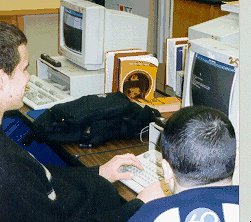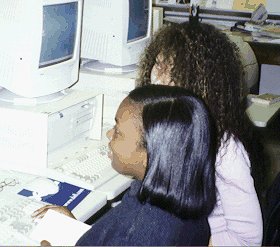|
Learning methods are diverse
One can't help but be reminded of Dewey's Democracy and Education. In speaking with many educators we are amazed at how those who quote Dewey, usually do it in reference to "learning by doing," and not so much in his views on diversity. In addition to technology being useful to his "doing" theory, technology is tantamount to promoting diversity, access, and expression. Robert L. Fried relies on Dewey when he reveals, "I have been polishing John Dewey's argument that nothing much of lasting AUTHENTIC value happens in a classroom unless the students' minds are engaged in ways that connect with their experiences." (Fried, p2) Gardner in Frames of Mind talks about how we should take the individual student into account and offer him a variety of ways to display his skills. Many of us have bought into the concept of multiple intelligences, yet few have actually tapped into their students' varied abilities. Knowing that many people are looking at their webpages, and wanting to show off their unique talents and interests, my students have been able to use this forum. Barry LaVergne, a talented musician as well as a talented writer, used his webpage as a place to display his musical ability. He writes at length about the importance of music in his life, his musical mentors, and has included recordings of himself playing the guitar.
Technology provides the platform upon which diversity can actually be an advantage to the learner. The Internet in particular has provided great access to texts and stories that celebrate and define our diversity. With diversity comes additional tensions. Oftentimes, these tensions create important paradoxes to help us carry out our pedagogy explains Parker Palmer. Lori's scholars are wrestling with memoirs that help them to see both the differences and similarities shared by us all. My students write memoirs that are, at the same time, PERSONAL and universal. While Leela's story about her mother missing her graduation is uniquely hers, many of us have experienced the feeling of disappointment that she describes. In this way, our diversity brings us together. Ted has a special project he does in December. The Holiday Scavenger Hunt introduces the class to the various holiday celebrations in December. This provides a forum for discussions of diversity in this very celebratory time. Paradoxically, it shows how uniform we are in the stories and traditions we share. I always find it so eye opening for the students as they learn more about their own method of celebration. They come with prior knowledge and use it as a springboard to acquire more. They begin to share stories and begin to understand the fabric themeselves and those around them. And that is just for December. Consider what a colleague of ours from South Dakota, Pat Schulze has created a project based lesson for Civil Rights Study. Other considerations for Women's History month or Poetry month. Creating a thematic web is always a good project for a teacher to begin with.
Prior Knowledge
Here's a perfect example of how the technology enhances learning while incorporating a personal touch in a public arena and tapping into the diversity and experience of the students.
Dissent Education thrives in the diverse environment which taps prior knowledge and allows dissent. Diversity and education are crucial for the survival of the democracy. Pradl expounds on this. Diversity and Standardization are a paradoxical pair we encounter in our classrooms everyday. Everyday we urge our students to learn, collaborate, and engage in the act of DOING their work on the Internet. At the same time we are asking them to respond to a standardized test for acknowledgment. It is our belief that some compromise between standardized tests and authentic assessment can be reached in the very near future. Unfortunately, with the reliance of assessment falling solely to standardized tests, the use of cyber rooms is in jeopardy. As administrators are relying more and more on drill and kill and practice, practice, practice to prepare the students for the test, there is little room for diversity.
© TedNellen & Lori Mayo 2000 |
 s teachers, we too have selves and histories that must be heard.." writes Gordon Pradl in Literature for Democracy: Reading as a Social
Act. We like how Pradl honors the teacher, who is oftimes forgotten. He goes further to suggest that teachers should model for their students by creating their own representation of their own history. Identity is crucial to learning and knowing who we are. That is what we all have in common, identity. After that we are all different. We learn differently. We are unique. We are all individuals. Seems as if Pradl is suggesting we should honor our diversity by letting our histories be known so we can create a better learning environment. By knowing our histories we are able to tap prior knowledge as we accept new knowledge in negotiation and adaption to overcome the paradoxes we constantly confront along our learning path and gain authority and
s teachers, we too have selves and histories that must be heard.." writes Gordon Pradl in Literature for Democracy: Reading as a Social
Act. We like how Pradl honors the teacher, who is oftimes forgotten. He goes further to suggest that teachers should model for their students by creating their own representation of their own history. Identity is crucial to learning and knowing who we are. That is what we all have in common, identity. After that we are all different. We learn differently. We are unique. We are all individuals. Seems as if Pradl is suggesting we should honor our diversity by letting our histories be known so we can create a better learning environment. By knowing our histories we are able to tap prior knowledge as we accept new knowledge in negotiation and adaption to overcome the paradoxes we constantly confront along our learning path and gain authority and 
